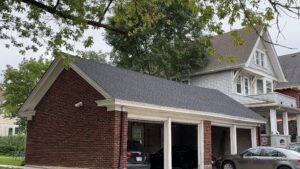When it comes to roofing installations, the key to a long-lasting and durable roof is proper installation. The unique weather conditions in Wisconsin, including heavy snow, rain, and freezing temperatures, make it crucial to have your roof installed with precision and attention to detail.
In this guide, we’ll walk you through the steps to a proper roofing installation, and highlight the specific considerations homeowners in Wisconsin need to keep in mind.
Why Proper Roofing Installation Matters in Wisconsin
The climate in Wisconsin can be harsh, with winter temperatures dropping below freezing and heavy snowfall adding weight and stress to your roof. If not installed properly, your roof can suffer costly damage, from leaks and mold to structural issues. That’s why it’s important to work with experienced professionals who understand the local conditions and can ensure your roofing installation will stand the test of time.
If you have a tight budget and wish to install a new roof, read this article on home improvement loans.
Step-by-Step Guide to Roofing Installations in Wisconsin
1. Assess Your Roofing Needs
Before beginning any roofing project, it’s important to assess your current roof’s condition. Whether you’re installing a new roof or replacing an old one, understanding the specific challenges your home faces is critical. In Wisconsin, this often includes:
- Snow load concerns
- Ice dam formation
- High winds during storms
By assessing your roof’s needs, you can select the best materials and installation methods for your home.
2. Choose the Right Roofing Material
The material you choose for your roofing installation will significantly impact its longevity and performance. For Wisconsin homes, the best roofing materials that are tested and proven to withstand the region’s unique weather patterns include:
- Asphalt Shingles: Cost-effective and durable, they are a popular choice for many homeowners.
- Metal Roofing: Resistant to extreme weather, metal roofing is excellent for shedding snow and ice.
- Slate and Tile Roofing: These materials offer superior durability but come with a higher cost.
Consider materials with higher insulation ratings to help keep your home warm during Wisconsin’s frigid winters.
3. Ensure Proper Roof Ventilation
Wisconsin’s varied climate – from hot summers and cold winters – requires proper roof ventilation to prevent moisture buildup, mold growth, and insulation damage. During the installation process, ensure that:
- Soffit vents are properly placed to allow cool air to enter.
- Ridge vents are installed to expel warm, moist air from the attic.
Proper ventilation also helps prevent ice dams, a common problem in Wisconsin. This happens when warm air escapes from the attic, then melts snow on the roof, which refreezes and forms ice dams along the roof’s edge.
4. Install a High-Quality Ice and Water Shield
In Wisconsin, adding an ice and water shield is a must for any roofing project. This protective layer helps creates a waterproof barrier underneath the shingles, preventing leaks in areas most prone to water damage such as:
- Roof valleys
- Around chimneys and vents
- Along the eaves
Investing in high-quality ice and water shielding will protect your home from the freeze-thaw cycles that can cause significant damage.
5. Pay Attention to Flashing
Quality flashing seals offer crucial protection against water damage. It directs water away from seams and joints, protecting your home from water infiltration and potential damage. Flashing is typically installed around:
- Chimneys
- Skylights
- Roof edges
Be sure your roofing contractor uses high-quality flashing and installs it correctly for maximum protection.
6. Proper Insulation is Key
Wisconsin winters are no joke, and proper insulation plays a vital role in keeping your home warm and energy-efficient. During the installation process, ensure that your attic and roof are adequately insulated. This helps:
- Reduce heating costs during the winter
- Prevent ice dams from forming
- Protect your roof’s structural integrity
7. Conduct a Final Inspection
After your roofing installation is complete, it’s essential to conduct a thorough inspection to ensure everything was done correctly. This includes checking for:
- Proper alignment of shingles
- Secure flashing around vents and chimneys
- Sufficient ventilation and insulation
A final inspection can help catch any small issues before they become costly repairs down the road.
The Importance of Hiring Professional Roofers in Wisconsin
Given the specific challenges that Wisconsin’s weather presents, hiring a professional roofing contractor ensures your roof is installed to withstand the region’s toughest conditions. Look for contractors with experience in:
- Installing roofs in cold climates
- Handling snow and ice load concerns
- Using high-quality materials suited for the Midwest
A professional roofer will complete your roof installation to the highest standards, giving you peace of mind during the next snowstorm.
Trust Elegant Builders for Your Roofing Installations
At Elegant Builders, we understand the unique demands that Wisconsin’s climate puts on your roof. Our team of experienced roofing professionals is dedicated to providing top-quality roofing installations that are built to withstand the harshest weather conditions. Whether you need a new roof or are replacing an old one, we’re here to help you choose the best materials and ensure a flawless installation.








